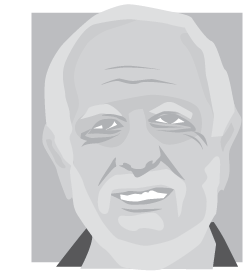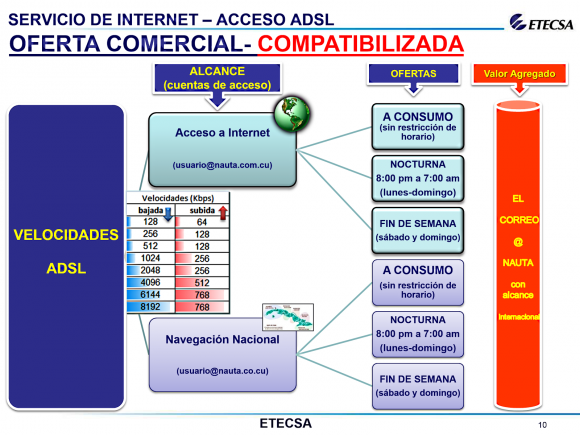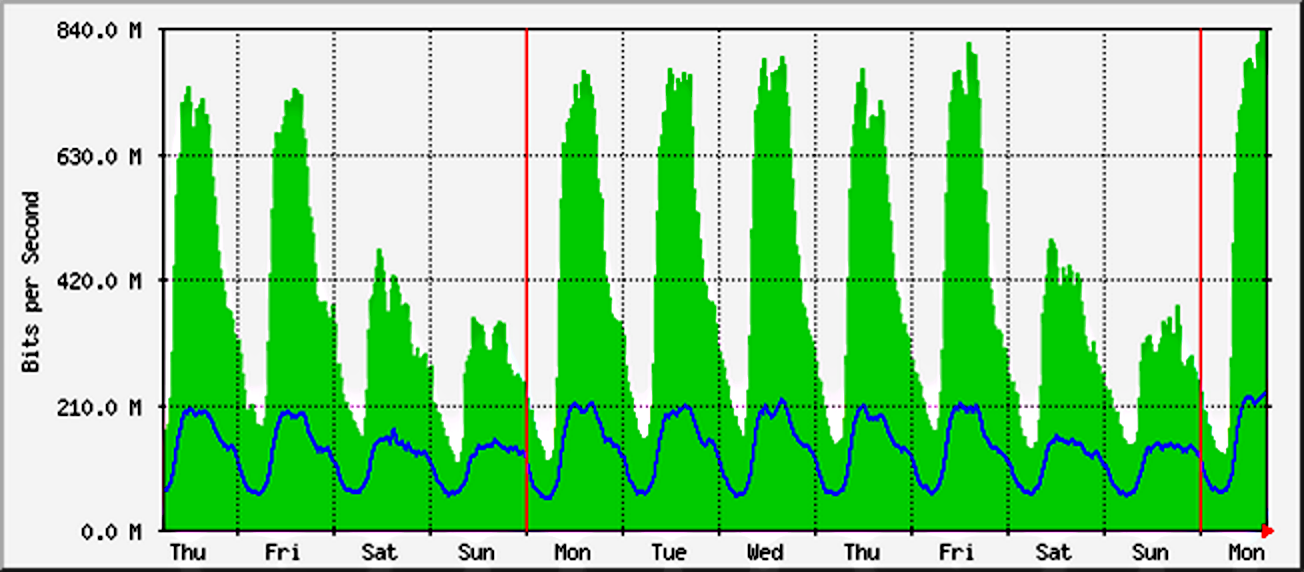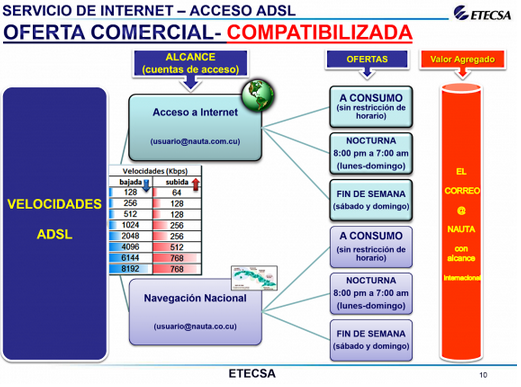aNewDomain — Few Cubans are eligible for home Internet connectivity, and nearly all those that are eligible have dial up links. Very few have ever had even the possiblity of a DSL connection. According to a leaked slide presentation from Cuba state-owned telecom firm, Empresa de Telecomunicaciones de Cuba S.A. (ETECSA), that’s about to change.
— Few Cubans are eligible for home Internet connectivity, and nearly all those that are eligible have dial up links. Very few have ever had even the possiblity of a DSL connection. According to a leaked slide presentation from Cuba state-owned telecom firm, Empresa de Telecomunicaciones de Cuba S.A. (ETECSA), that’s about to change.
Carlos Alberto Pérez posted a leaked powerpoint presentation on the home connectivity plan of Cuba’s state monopoly Internet service provider, ETECSA.
ETECSA has denied the validity of the leaked document, claiming it was created for training purposes only. The organization said that prices shown (in a slide below) are incorrect, and that they do not reflect whatever real prices will be used.
But ETECSA did not retract the substance of the presentation, which clearly demonstrates a plan to install DSL service to some Cuban homes using Chinese equipment.
ETECSA’s Presentation
ETECSA’s plan shows a surprising number of details. One detail shows asymmetric DSL service in an undetermined number of central offices, which means a faster download than upload speed.
The Chinese equipment in the presentation, shown in the leaked slide below, are Huawei ME 60 gateways, as I’ve predicted in earlier columns here. All will connect the IP networks and phones. It’s quite a coup for Huawei, by the way.

It would be reasonable to guess that the digital multiplexers (DSLAMs) used in the central offices will be from Huawei, too.
Now look at another leaked ETECSA slide, below. This one contains information that ETECSA has previously denied. It claimed the figures were for training purposes, and I believe it. But this slide gives us a baseline from which we can start analyzing the numbers:

These prices may be higher than what will be charged in reality, but there will surely be a significant number of people who cannot afford a DSL connection. It’s easy to imagine people sharing accounts and, also, the development of a black resellers market.
The following slide differentiates between national and international access, so I presume that the actual prices will take that into account. That would be reasonable since international traffic must either go over slow satellite links or be routed over a limited hybrid fiber/wireless backbone connecting to the ALBA-1 undersea cable landing at the east end of the island. The slides say nothing about which, if any, international sites will be blocked.

The above slide also differentiates speed levels, times of day and days of the week. I suspect the actual pricing will take time and day into account, but that may or may not be the case for the different speeds that are shown. Varying infrastructure will cause speed differences regardless of price.
Before a home can receive DSL service, the equipment in the central office serving it must be upgraded, and a relatively short, high quality phone line must run between the home and its central office.
Major Upgrade
Cuba reported 3,882,424 private homes and 939,500 residential phone lines in 2012. That means around 2.9 million homes would have to be wired before they could have Internet service. The presentation says they will give priority to homes that already have land lines and those belonging to the self-employed. (The former is obvious and the latter interesting.)
Cuba reports having 688 central offices as of 2013, few of which contain DSL equipment. Most would have to be upgraded in order to provide DSL service.
Once connected, what will the data transmission speed be? The above slide shows asymmetric connection speeds ranging from 128/64KB to 8,192/768KB per second. With DSL technology, transmission speed depends upon the distance of a home from its central office and the condition of the copper lines connecting them. These are always best effort numbers — “up to” the stated speeds.
Let me give an example. I live in Los Angeles and Google Maps says I am 1.1 mile from my central office. Verizon offers me two service levels: “high speed” DSL service is .5-1MBps and “enhanced” service is from 1.5-3MBps for an extra $10 per month. To be fair, the copper in my neighborhood is 70 years old, but I doubt that many Cuban customers will be able to get 8,192KBps.
There’s also a slide showing day/night and weekday/weekend traffic patterns (see below). Judging from the y-axis, I am guessing that this is showing international traffic, which is heavy during weekdays. Before a user logs on, he or she will be able to measure their current connection speed before starting a session and using their hours.

Internet Connection Speed
The Internet connection is the second question mark in the previous diagram. What are the connection speeds between the central offices and the Internet? In the U.S., central offices are connected by high speed fiber, but I know little about Cuba. For example, in Havana, some or all central offices may be connected to a fiber backbone, but what of the link from there to the Internet? Havana is far from the undersea cable landing to the east, so I imagine those links are via congested satellites.
The bottom line is that this is an early step toward modern home connectivity using yesterday’s technology, and I hope Cubans are planning to leapfrog today’s technology in the long run.
Well, that’s a small tea leaf reading of the leaked slides. It’s too bad that the situation is so opaque that we have to guess about ETECSA and its plans. The involvement of Chinese suppliers may be the most interesting thing in this leak — I wonder if they’re also supplying equipment for that hybrid fiber-wireless backbone.
For aNewDomain, I’m Larry Press.
Ed: A version of this story ran on Larry Press’ laredcubana. Read it here.
All images: courtesy of Carlos Alberto Pérez and ETECSA
Larry Press is executive editor of the upcoming Cubanews.net site from aNewDomain Media. Stay tuned.













